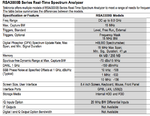SherlockBenedict
Member level 4
I know that the concept of negative frequencies seems to be absurd. I have been searching for the answer for quite a long time.
One answer that I mostly saw was that it was because of the Euler's theorem.
But now I have another reason-
Here's one real negative frequency as given in Proakis-
There are two waves one is 1/8 Hz and other one is -7/8 Hz.

I can even prove this mathematically.
Consider a sine wave y=sin wt.
Now consider an initial phase shift of Π
This means that
y= sin (wt + Π)= -sin wt = sin (-wt).
So clearly the frequency has become negative!
Now I believe that this is the real meaning of negative frequency.
What's your answer?
Awaiting for your reply
Thanks a lot.......
One answer that I mostly saw was that it was because of the Euler's theorem.
But now I have another reason-
Here's one real negative frequency as given in Proakis-
There are two waves one is 1/8 Hz and other one is -7/8 Hz.

I can even prove this mathematically.
Consider a sine wave y=sin wt.
Now consider an initial phase shift of Π
This means that
y= sin (wt + Π)= -sin wt = sin (-wt).
So clearly the frequency has become negative!
Now I believe that this is the real meaning of negative frequency.
What's your answer?
Awaiting for your reply
Thanks a lot.......
